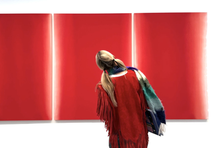Francis Bacon: Man and Beast by Sarah Mackay
- The Courtauldian
- Aug 10, 2023
- 3 min read
15 February 2022

Francis Bacon, Crucifixion, 1933, oil on canvas, Private Collection © The Estate of Francis Bacon/DACS 2015
The Royal Academy’s Francis Bacon: Man and Beast is as stunning as it is shocking. The show is the first exhibition to centre on Bacon’s fascination with animals, specifically how they informed and distorted his approach to the human form. The show itself is extensive, showcasing works from throughout the entirety of his 50-year career, beginning with his first successful painting – the Crucifixion (1933) – and ending with his final work, a pared-down rendering of the figment of a bull called Study of a Bull (1991). In between the two, simian shrieks, contorted physiognomies, flayed carcasses, and blotches of ox blood ravage the canvases throughout the galleries. Truly dreadful, but profoundly perceptive, these paintings provide a cautionary commentary on mankind’s subliminal primal nature. Francis Bacon was born in 1909 in Dublin, Ireland. His father was a horse-breeder, and so much of his childhood was spent around animals. While his chronic asthma kept him at a safe distance, throughout his life he maintained an intense infatuation with animals’ psychologies and instincts. Bacon’s childhood was deeply traumatic; openly homosexual, he was abused and ridiculed by his father, and thrown out of his home at the age of 16. This experience would affect his sexual encounters throughout his life, such as in his well-known, tortuous, and abusive relationship with his patron Eric Hall throughout the late 1920s and early 1930s. The artist also endured the utter devastation and damage caused by both World Wars, the first as only a young child. For Bacon, the culmination of these harrowing events revealed the violent, bestial nature of man – in the end, it would seem, we are all simply savages.

Francis Bacon, Head VI, 1949, oil on canvas, Arts Council Collection, Southbank Centre, London © The Estate of Francis Bacon. All Rights Reserved. DACS 2015
Bacon’s works are distinctly painterly, flecked with the occasional abstract-expressionist paint splatter, and always teeming with maddened gestural quality. Bodies bend beyond recognition into ape-like monstrosities blurring the boundaries between animal and human bodies, and petrified portraits haunt like ghostly x-rays. One riveting highlight is the artist’s Head VI (1949), Bacon’s first reference to Diego Velázque’s Portrait of Pope Innocent X (1650). Secluded within an imagined box, the Pope seems subsumed by a sort of bestial madness, an animal trapped in a cage. Rapid, thin brushstrokes of black paint sweep upwards from his head as if his face, horrifyingly frozen in an anguished scream, is being sucked away cell by cell.

Francis Bacon, Two Figures, 1953, oil on canvas, Private Collection © The Estate of Francis Bacon. DACS/Artimage
Pulling from an array of source material – Edward Muybridge’s photography book Human and Animal Locomotion, magazine images, his own visits to zoo, amongst many others – Bacon delves into every facet of the interchangeability of man and beast from the physical to mental. A particularly touching work, Bacon’s Two Figures (1953) reveals the artist’s interest in male-wrestling, a sport that allowed him to legally express his homoerotic feelings through painting. As two men tussle amongst hastily rendered white sheets, one bares his teeth in a savage grin. The men’s intertwined bodies seem caught in an animalistic mating ritual. The scene is stirring, yet poignant when one considers the artist’s personal history.

Francis Bacon, Second Version of Triptych 1944, 1988, oil and acrylic on canvas, Tate Britain, London
While it may give you nightmares, Francis Bacon: Man and Beast is entirely worth seeing, even for the loans alone. With six complete triptychs, numerous works from private collections, and the three bull fights brought together for the first time, the exhibition is an unparalleled opportunity to slide into the Bacon’s enthralling, albeit cynical, mind. Raw, tormented, and anxiety-ridden, Bacon’s animal-human hybrids hold enduring significance – they are constant reminders of the beast within us, waiting for the right moment to rear its ugly head. Francis Bacon: Man and Beast is on view at the Royal Academy, London, from 29 January to 17 April.












Comments